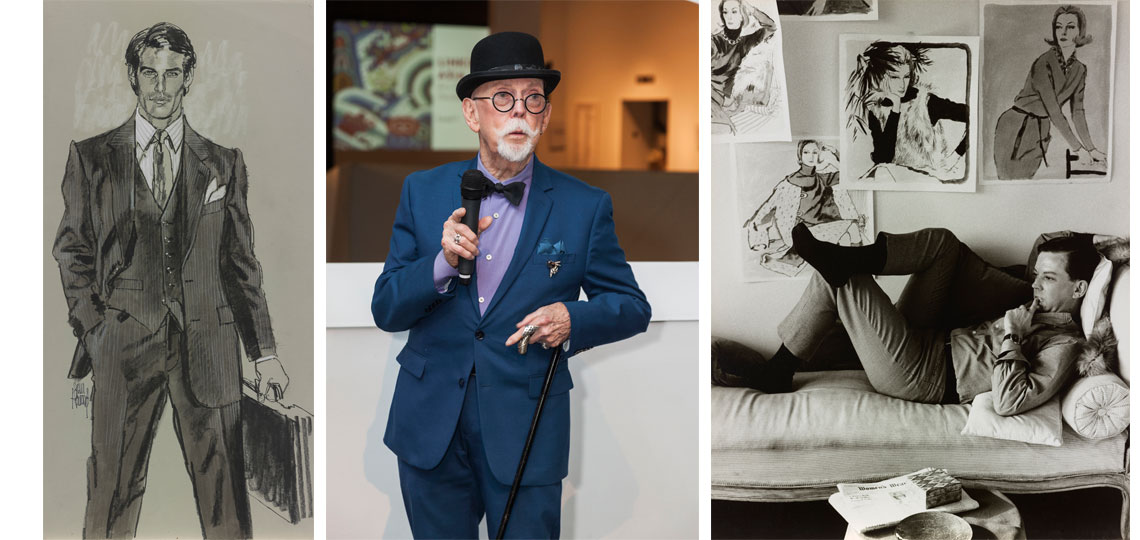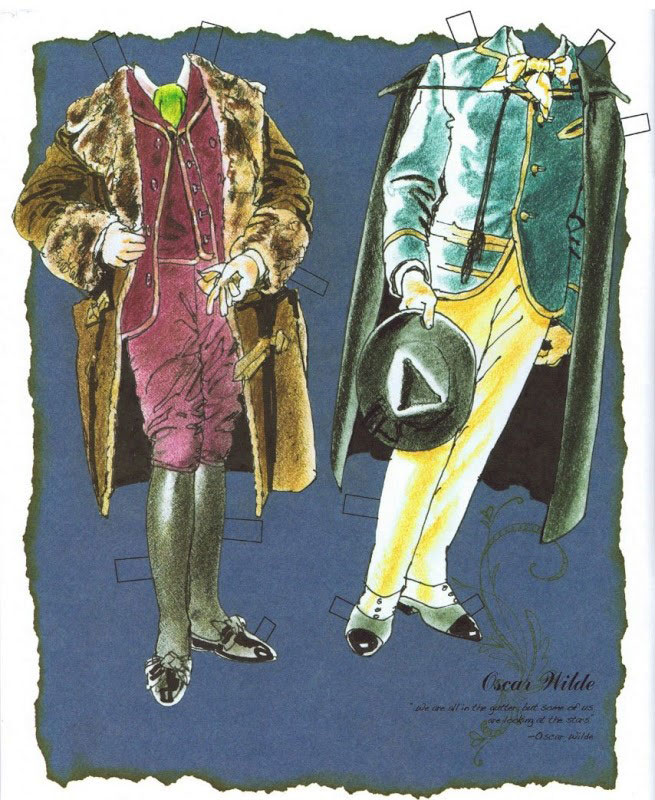Drawn to Glamour: Fashion Illustrations by Jim Howard was on view March 25, 2018–Aug 5, 2018.
In conjunction with the exhibition Drawn to Glamour: Fashion Illustrations by Jim Howard (on view through August 5), this blog explores the history of dandyism through the lives and styles of two of the decidedly dapper icons featured in the paper doll book Four Famous Dandies.
Meet the Artist
The book’s author, Jim Howard, is an esteemed fashion illustrator who also happens to be our own resident dandy, and the subject of the current exhibition Drawn to Glamour.
Visit the exhibition 11 am–1 pm on Wednesdays July 4–August 1 to chat with Jim Howard. (Yes, we’re open on Independence Day!)
Dandies: Challenging Stereotypes
Dandies are an integral part of fashion history. They challenged the status quo and transgressed the bounds of what was stereotypically “masculine.” Read on to learn more about two of the timeless style stars featured in Four Famous Dandies whose influences are still present in the culture and fashions of today.
George Bryan “Beau” Brummell (1778–1840)
Often hailed as the forefather of men’s style, George Brummell—more commonly referred to as Beau Brummell—is to thank for many things still favored in menswear today. He was born in London in 1778 at a time when men’s fashion favored extreme embellishment, oversized silhouettes, and dramatic wigs and makeup.
Abandoning the overindulgent stylings worn by the high-powered aristocrats of the time, Brummell favored simple lines and sleek silhouettes, replacing billowy tunics with well-tailored suits and colorful pieces with their monochromatic counterparts. His used his distinct sense of style, good looks, and a generous amount of charm and wit to climb the social ladder to the top, eventually becoming one of the Prince of Wales’ ( who would later become King George IV) closest acquaintances.
Through this connection Brummell was given a commission in the army and over the years was promoted to captain. His time in the army may have influenced his personal style, leading him to prefer function over form, characteristics commonly found in military uniforms. After leaving the army, he reached the height of his fame and influence and was considered to be the best dressed gentleman in England. He began putting even more effort into perfecting his image, taking over five hours to get ready for outings, and even going as far as to polish his shoes with champagne.
Eventually this over-the-top lifestyle took its toll and he found himself up to his crisp white collar in debt. He spent the rest of his life on the run, finding himself constantly in and out of prison until 1840 when he met a painful demise from syphilis. Though his story may not have a happy ending, he transformed the notions of what was fashionable in the late eighteenth century, the effects of which are still seen in fashion today.
Oscar Wilde (1854–1900)
Known for his eccentric sense of style, this-larger-than life dandy was far ahead of his time. Centuries before magazines were filled with carefully photoshopped images and life was viewed from behind an Instagram filter, Oscar Wilde became a self-made celebrity. With his velvet jackets, floral accents, and long hair, Wilde was a living caricature.
A true fashion pioneer, Wilde shunned the ever-changing trends that went along with fashion, instead wearing whatever he felt drawn to regardless of the current fashion forecast, which allowed him to truly cultivate a unique identity.
His persona only became more exaggerated as he rose to higher levels of fame and by 1880 Wilde turned his signature style into a promotional tour of lectures on the aesthetic movement, four of which were held in Colorado.
Later he moved to London (where he married and fathered two sons), traded in his long flowing hair for dramatic curls, and adopted a more sophisticated cosmopolitan sense of style. With his newly adjusted image he went on to become the editor of The Women’s World Magazine, and authored numerous essays, short stories, and plays. Some of these works put Wilde on the literary map and secured his place as a funny, poignant, dramatic visionary.
Some of his work was met with criticism and outrage because of homosexual references. Sexuality was a continuous source of conflict in Wilde’s life, and after a liaison with another man he was arrested on charges of “gross indecency” and sentenced to two years of imprisonment. Though he never lost his sharp wit or unique view of the world, prison took its toll and he died three years after being released.
Considered today to be one of the original models for gay rights, Oscar Wilde’s life in many ways foreshadowed the cultural movements that were to follow.
Jim Howard (American, b. 1930), Drawing, circa 1980. Charcoal pencil on paper. From the collection of Jim Howard; Jim Howard at the media preview for Drawn to Glamour. Jim Howard, Image courtesy of artist, circa 1965. © Jim Howard



